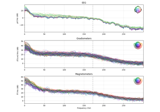mne.time_frequency.psd_multitaper#
- mne.time_frequency.psd_multitaper(inst, fmin=0, fmax=inf, tmin=None, tmax=None, bandwidth=None, adaptive=False, low_bias=True, normalization='length', picks=None, proj=False, n_jobs=None, reject_by_annotation=False, *, verbose=None)[source]#
Warning
DEPRECATED: Function
psd_multitaper()is deprecated; for Raw/Epochs/Evoked instances usespectrum = instance.compute_psd(method="multitaper")instead, followed byspectrum.get_data(return_freqs=True).Compute the power spectral density (PSD) using multitapers.
Calculates spectral density for orthogonal tapers, then averages them together for each channel/epoch. See [1] for a description of the tapers and [2] for the general method.
- Parameters:
- instinstance of
EpochsorRaworEvoked The data for PSD calculation.
- fmin, fmax
float The lower- and upper-bound on frequencies of interest. Default is
fmin=0, fmax=np.inf(spans all frequencies present in the data).- tmin, tmax
float|None First and last times to include, in seconds.
Noneuses the first or last time present in the data. Default istmin=None, tmax=None(all times).- bandwidth
float The bandwidth of the multi taper windowing function in Hz. The default value is a window half-bandwidth of 4.
- adaptive
bool Use adaptive weights to combine the tapered spectra into PSD (slow, use n_jobs >> 1 to speed up computation).
- low_bias
bool Only use tapers with more than 90% spectral concentration within bandwidth.
- normalization‘full’ | ‘length’
Normalization strategy. If “full”, the PSD will be normalized by the sampling rate as well as the length of the signal (as in Nitime). Default is
'length'.- picks
str| array_like |slice|None Channels to include. Slices and lists of integers will be interpreted as channel indices. In lists, channel type strings (e.g.,
['meg', 'eeg']) will pick channels of those types, channel name strings (e.g.,['MEG0111', 'MEG2623']will pick the given channels. Can also be the string values “all” to pick all channels, or “data” to pick data channels. None (default) will pick good data channels (excluding reference MEG channels). Note that channels ininfo['bads']will be included if their names or indices are explicitly provided.- proj
bool Whether to apply SSP projection vectors before spectral estimation. Default is
False.- n_jobs
int|None The number of jobs to run in parallel. If
-1, it is set to the number of CPU cores. Requires thejoblibpackage.None(default) is a marker for ‘unset’ that will be interpreted asn_jobs=1(sequential execution) unless the call is performed under ajoblib.parallel_backend()context manager that sets another value forn_jobs.- reject_by_annotation
bool Whether to omit bad segments from the data before fitting. If
True(default), annotated segments whose description begins with'bad'are omitted. IfFalse, no rejection based on annotations is performed.Has no effect if
instis not amne.io.Rawobject.- verbose
bool|str|int|None Control verbosity of the logging output. If
None, use the default verbosity level. See the logging documentation andmne.verbose()for details. Should only be passed as a keyword argument.
- instinstance of
- Returns:
See also
Notes
New in version 0.12.0.
References
Examples using mne.time_frequency.psd_multitaper#

The Spectrum and EpochsSpectrum classes: frequency-domain data
